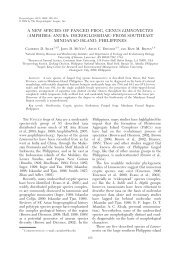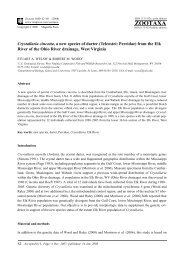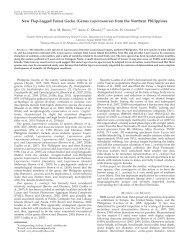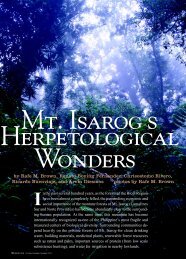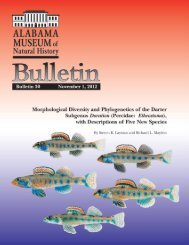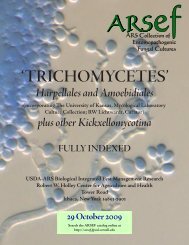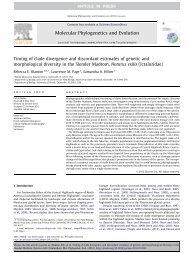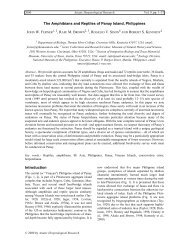a new species of scincid lizard (genus sphenomorphus) - BioOne
a new species of scincid lizard (genus sphenomorphus) - BioOne
a new species of scincid lizard (genus sphenomorphus) - BioOne
Create successful ePaper yourself
Turn your PDF publications into a flip-book with our unique Google optimized e-Paper software.
68 HERPETOLOGICA [Vol. 66, No. 1Past zoogeographic work has suggested astrong faunal relationship between Palawanand Borneo as a result <strong>of</strong> a possible landconnection during the last Pleistocene glacialmaximum (Heaney, 1986; Huxley, 1868; butsee Brown and Diesmos, 2009; Brown andGuttman, 2002). Huxley (1868) modified thenorthwestern portion <strong>of</strong> Wallace’s zoogeographicbarrier, separating the Philippines intotwo zoogeographic zones and placing PalawanIsland as part <strong>of</strong> the Sunda Shelf/Asian fauna.Brown and Guttman (2002) and McGuire andKiew (2001) provided some <strong>of</strong> the firstphylogenetic evidence suggesting that some<strong>of</strong> Palawan’s endemic amphibians and reptilesmay be more closely related to the oceanicportions <strong>of</strong> the Philippines, to the exclusion <strong>of</strong>the Sunda Shelf. With no clear distinction inthe literature on the affinity <strong>of</strong> Palawan fauna,it is critical to compare it with the fauna <strong>of</strong> bothBorneo and the oceanic Philippines.In this paper, we describe a <strong>new</strong> <strong>species</strong> <strong>of</strong>lygosomine skink from Palawan Island, foundduring a collaborative survey between ConservationInternational Philippines and the University<strong>of</strong> Kansas Biodiversity Institute. Weassign this <strong>new</strong> <strong>species</strong> to the <strong>genus</strong> Sphenomorphusbased on the presence <strong>of</strong> enlargedmedial precloacal scales that overlap lateralprecloacal scales; supradigital scales double ortriple and imbricate; hemipenes bifurcate; lack<strong>of</strong> undivided transparent scale in lower eyelid;four pentadactyl limbs; and fewer than 30subdigital lamellae on Toe IV (Lim, 1998; Sheaand Greer, 2002; Taylor, 1963). We furtherplace this <strong>species</strong> in the Sphenomorphusvariegatus Group (Greer and Parker, 1967a),which includes Philippine Group IV (Brownand Alcala, 1980), based on the followingexternal and internal characters: lack <strong>of</strong> postorbitalbone; supratemporal fenestra very small;no anterior projection <strong>of</strong> the ectopterygoidprocess; well developed digits and limbs whichoverlap when adpressed; and enlarged nuchalslacking. The Sphenomorphus variegatus Groupis spread throughout Asia and Southeast Asia,consisting <strong>of</strong> 37 <strong>species</strong> that are phenotypicallysimilar. We compare the <strong>new</strong> <strong>species</strong> to <strong>species</strong>in the S. variegatus Group as well as to <strong>species</strong>in geographic proximity to Palawan Island,Borneo, and the Philippines. We show that the<strong>new</strong> <strong>species</strong> differs from its congeners in thecombination <strong>of</strong> size at maturity, scale morphology,and coloration.MATERIALS AND METHODSA research team supported by ConservationInternational Philippines and the University<strong>of</strong> Kansas Biodiversity Research Center madecollections <strong>of</strong> animals in forested areas <strong>of</strong> Mt.Mantalingahan on Palawan Island during July2007. These researchers used multiple techniquesto collect the animals including captureby hand, pitfall traps, and snap traps. Theyfixed all specimens in 10% buffered formalinto preserve them, and after a few months thespecimens were transferred to 70% ethanol.Senior author CWL determined sex bygonadal inspection and performed measurementsusing Mitutoyo digital calipers to thenearest 0.01 mm.Measurements used are snout–vent length(SVL) measured from the tip <strong>of</strong> the snout tothe cloacal opening; tail length (TL) measuredfrom the cloacal opening to the tip <strong>of</strong> the tail;axilla–groin distance (AGD) measured fromthe posterior margin <strong>of</strong> the forelimb insertionto the anterior margin <strong>of</strong> the hind limbinsertion; head length (HL) measured fromthe anterior margin <strong>of</strong> the ear opening to thetip <strong>of</strong> the snout; head width (HW) measuredat the widest part <strong>of</strong> the temporal region;snout–forelimb length (SFL) measured fromthe anterior margin <strong>of</strong> the forelimb insertionto the tip <strong>of</strong> the snout; internarial distance(IND) measured between the dorsal margin<strong>of</strong> the two nares; rostrum length (RostL)measured from the anterior margin <strong>of</strong> the eyeto the tip <strong>of</strong> the snout; interorbital distance(IOD) width <strong>of</strong> orbital region at mid orbital;eye diameter (ED) measured at widest point;ear diameter (EarD) measured at widestpoint; forelimb length (FLL) measured frombase <strong>of</strong> palm to elbow; hind limb length(HLL) measured from knee to ankle.Scales were counted by CWL on the rightside <strong>of</strong> the body with a dissecting microscope.Scale counts include number <strong>of</strong> paravertebralscales (PVSR), dorsoventral scales between theparietals and the scales at the cloaca on thedorsal side; number <strong>of</strong> midbody scale rows(MBSR), scale rows around the middle <strong>of</strong> thebody; number <strong>of</strong> subdigital lamellae on Toe IV(SDL); number <strong>of</strong> supralabials (SL); number <strong>of</strong>



